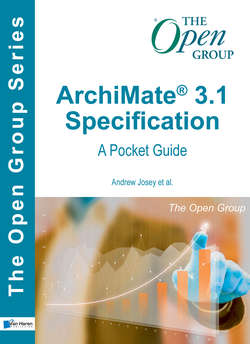Читать книгу ArchiMate® 3.1 - A Pocket Guide - The Open Group - Страница 6
На сайте Литреса книга снята с продажи.
Contents
ОглавлениеChapter 1 Introduction
1.1 Introduction to the ArchiMate Specification
1.2 ArchiMate Specification Overview
1.3 The ArchiMate Language and Enterprise Architecture
1.3.1 The ArchiMate Language and the TOGAF ADM
Chapter 2 Language Structure
2.1 Top-Level Language Structure
2.2 Layering of the ArchiMate Language
2.3 Use of Colors and Notational Cues
2.4 The ArchiMate Core Framework
2.5 The ArchiMate Full Framework
Chapter 3 Generic Metamodel
3.1 Behavior and Structure Elements
3.1.1 Active Structure Elements
3.1.2 Behavior Elements
3.1.3 Passive Structure Elements
3.2 Specializations of Structure and Behavior Elements
3.3 Motivation Elements
3.4 Composite Elements
3.4.1 Grouping
3.4.2 Location
Chapter 4 Relationships
4.1 Structural Relationships
4.2 Dependency Relationships
4.3 Dynamic Relationships
4.4 Other Relationships
4.5 Relationship Connectors
4.6 Examples
4.6.1 Composition Relationship
4.6.2 Aggregation Relationship
4.6.3 Assignment Relationship
4.6.4 Realization Relationship
4.6.5 Serving Relationship
4.6.6 Access Relationship
4.6.7 Influence Relationship
4.6.8 Association Relationship
4.6.9 Triggering Relationship
4.6.10 Flow Relationship
4.6.11 Specialization Relationship
4.6.12 Junction
4.7 Derivation of Relationships
Chapter 5 Motivation Elements
5.1 Motivation Elements Metamodel
5.2 Motivation Elements Summary
5.3 Examples
5.3.1 Stakeholder, Driver, and Assessment
5.3.2 Goal, Outcome, Principle, Requirement, and Constraint
5.3.3 Meaning and Value
5.4 Relationships with Core Elements
Chapter 6 Strategy Elements
6.1 Strategy Elements Metamodel
6.2 Strategy Elements Summary
6.3 Strategy Elements Examples
6.4 Relationships with Motivation and Core Elements
Chapter 7 Business Layer
7.1 Business Layer Metamodel
7.2 Active Structure Elements
7.3 Behavior Elements
7.4 Passive Structure Elements
7.5 Composite Elements
7.6 Examples
7.6.1 Business Active Structure Elements
7.6.2 Business Behavior Elements
7.6.3 Business Passive Structure Elements
7.6.4 Business Composite Element: Product
Chapter 8 Application Layer
8.1 Application Layer Metamodel
8.2 Active Structure Elements
8.3 Behavior Elements
8.4 Passive Structure Concepts
8.5 Examples
8.5.1 Application Active Structure Elements
8.5.2 Application Behavior Elements
8.5.3 Application Passive Structure Elements
Chapter 9 Technology Layer
9.1 Technology Layer Metamodel
9.2 Active Structure Elements
9.3 Behavior Elements
9.4 Passive Structure Elements
9.5 Examples
9.5.1 Technology Active Structure Elements
9.5.2 Technology Behavior Elements
9.5.3 Technology Passive Structure Element: Artifact
Chapter 10 Physical Elements
10.1 Physical Elements Metamodel
10.2 Active Structure Elements
10.3 Behavior Elements
10.4 Passive Structure Elements
10.5 Physical Elements Example
Chapter 11 Relationships between Core Layers
11.1 Alignment of Business Layer and Lower Layers
11.2 Alignment of Application and Technology Layers
11.3 Cross-Layer Relationships Example
Chapter 12 Implementation and Migration Elements
12.1 Implementation and Migration Elements Metamodel
12.2 Implementation and Migration Elements
12.3 Implementation and Migration Elements Example
12.4 Relationships
12.5 Relationships to Other Aspects and Layers
Chapter 13 ArchiMate Viewpoints
13.1 Architecture Views and Viewpoints
13.2 Viewpoint Mechanism
Appendix A
Changes from Version 3.0.1 to Version 3.1
Glossary
Index
